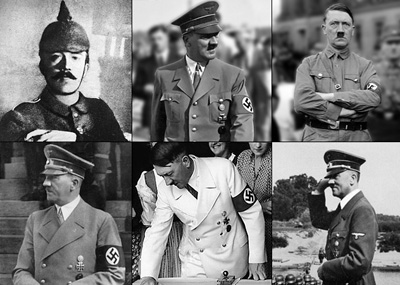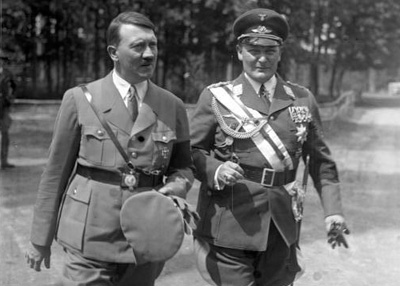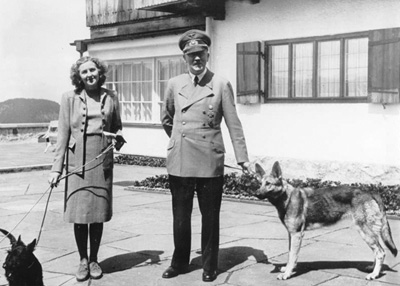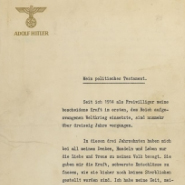
41 photos for Document
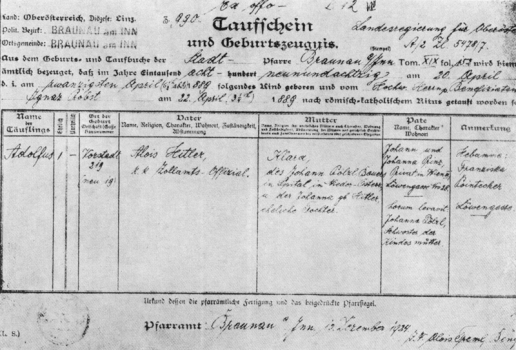
20 April 1889
Birth certificate of Adolf Hitler, born in the Austrian town of Braunau am Inn. His father was Alois Hitler and his mother Klara
Birth certificate of Adolf Hitler, born in the Austrian town of Braunau am Inn. His father was Alois Hitler and his mother Klara
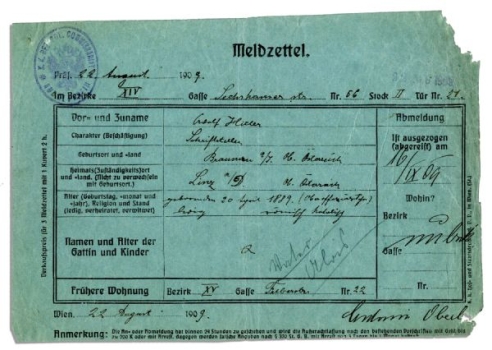
22 August 1909
Adolf Hitler's registration form from August 21, 1909, this time as a “writer”, at Sechshauserstrasse 56, 2nd floor, room 21, with Ms. Antonie Oberlechner, in the XIV district
Adolf Hitler's registration form from August 21, 1909, this time as a “writer”, at Sechshauserstrasse 56, 2nd floor, room 21, with Ms. Antonie Oberlechner, in the XIV district

14 October 1918
During the night, the British troops launched a gaz attack on a small hill near the town of Wervicq, near Lille. Adolf Hitler is blinded by the mustard gaz and transfered to the Pasewalk hospital, where he stayed until the end of the war.
During the night, the British troops launched a gaz attack on a small hill near the town of Wervicq, near Lille. Adolf Hitler is blinded by the mustard gaz and transfered to the Pasewalk hospital, where he stayed until the end of the war.

20 February 1920
The DAP (Deutsche Arbeiterpartei) is officially renamed NSDAP (Nationalsozialistische Deutsche Arbeiterpartei) - Example of an early member card
The DAP (Deutsche Arbeiterpartei) is officially renamed NSDAP (Nationalsozialistische Deutsche Arbeiterpartei) - Example of an early member card

24 February 1920
Adolf Hitler presents the 25 points program of the NSDAP (Das 25-Punkte-Programm der Nationalsozialistischen Deutschen Arbeiterpartei) at the first public meeting of the party in Munich's Hofbräuhaus
Adolf Hitler presents the 25 points program of the NSDAP (Das 25-Punkte-Programm der Nationalsozialistischen Deutschen Arbeiterpartei) at the first public meeting of the party in Munich's Hofbräuhaus
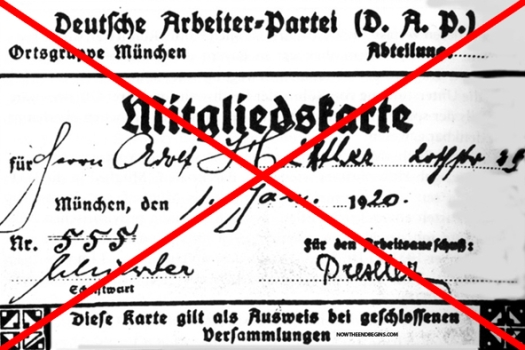
11 July 1921
Adolf Hitler announces his resignation from the party after an alliance was formed to counter his leadership, and gives an ultimatum that he would only return if given dictatorial powers
Adolf Hitler announces his resignation from the party after an alliance was formed to counter his leadership, and gives an ultimatum that he would only return if given dictatorial powers
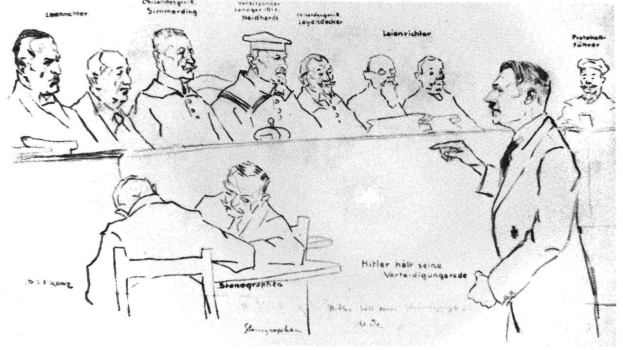
3 March 1924
Hitler defending himself at the court after the failed putsch of 1923 in Munich. The drawings were made by Otto D. Franz and Carl August Jaeger.
Hitler defending himself at the court after the failed putsch of 1923 in Munich. The drawings were made by Otto D. Franz and Carl August Jaeger.

1 April 1924
Cover sheet of the judgment of the putsch trial listing personal details of the accused and their sentence
Cover sheet of the judgment of the putsch trial listing personal details of the accused and their sentence
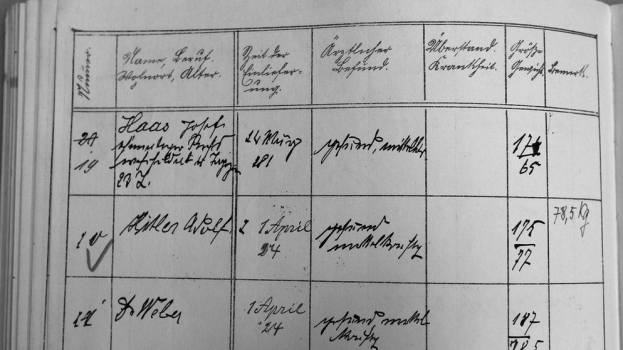
1 April 1924
Incarceration register of Adolf Hitler in Landsberg's fortress indicating he is prisoner number 10, healthy, measures 1,75 cm and weights 77 kgs (78,5 kgs the day of his release)
Incarceration register of Adolf Hitler in Landsberg's fortress indicating he is prisoner number 10, healthy, measures 1,75 cm and weights 77 kgs (78,5 kgs the day of his release)
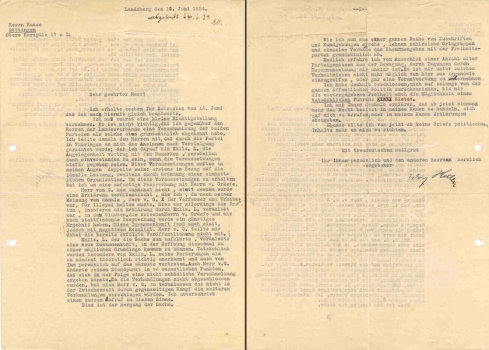
16 June 1924
Adolf Hitler announces his withdrawal from public politics as long as he stays in jail, and asks that no one acts or speaks in his name during that time
Adolf Hitler announces his withdrawal from public politics as long as he stays in jail, and asks that no one acts or speaks in his name during that time
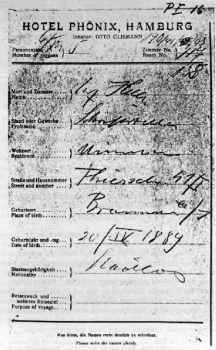
7 April 1925
Adolf Hitler requests to be released from Austrian citizenship and obtains the official consent of the Austrian government, making him stateless. Pictured is a hotel receipt from 6 Oct. 1927 where Hitler wrote Staatlos under nationality
Adolf Hitler requests to be released from Austrian citizenship and obtains the official consent of the Austrian government, making him stateless. Pictured is a hotel receipt from 6 Oct. 1927 where Hitler wrote Staatlos under nationality

11 November 1931
Ticket for a speech by Adolf Hitler in Mainz's Stadthalle in front of 20,000 participants
Ticket for a speech by Adolf Hitler in Mainz's Stadthalle in front of 20,000 participants

26 February 1932
Adolf Hitler had renounced his Austrian citizenship in 1925. After years of being stateless, Wilhelm Frick managed to appoint him as a Braunschweig government official that came with automatic German citizenship, allowing to take part of the elections.
Adolf Hitler had renounced his Austrian citizenship in 1925. After years of being stateless, Wilhelm Frick managed to appoint him as a Braunschweig government official that came with automatic German citizenship, allowing to take part of the elections.
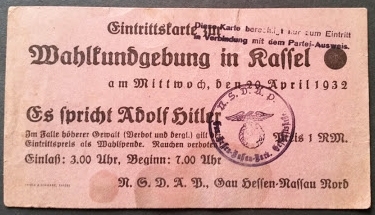
20 April 1932
Ticket for a speech by Adolf Hitler in Kassel, in front of 40,000 participants
Ticket for a speech by Adolf Hitler in Kassel, in front of 40,000 participants
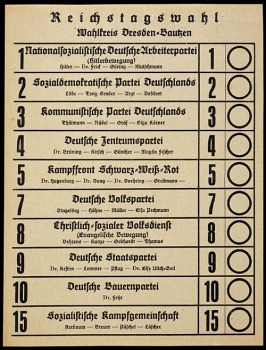
31 July 1932
After the dissolution of the Reichstag, Adolf Hitler and the NSDAP gained 230 seats with 37% of the votes at the July elections (pictured is a ballot for the 10 main parties)
After the dissolution of the Reichstag, Adolf Hitler and the NSDAP gained 230 seats with 37% of the votes at the July elections (pictured is a ballot for the 10 main parties)
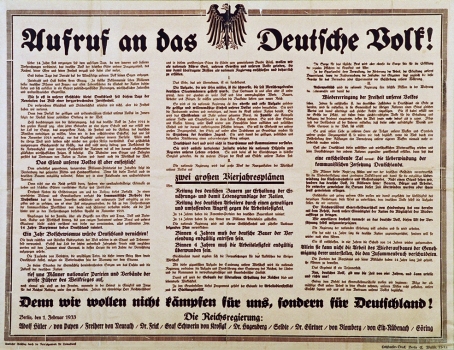
1 February 1933
Original text of Adolf Hitler's first proclamation to the German people as Chancellor
Original text of Adolf Hitler's first proclamation to the German people as Chancellor

28 February 1933
The day after the Reichstag fire, and following Hitler's advice, president Hindenburg issues the Reichstagsbrandverordnung (Reichstag Fire Decree), which nullified most of the civil and political liberties in Germany
The day after the Reichstag fire, and following Hitler's advice, president Hindenburg issues the Reichstagsbrandverordnung (Reichstag Fire Decree), which nullified most of the civil and political liberties in Germany
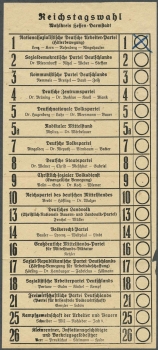
5 March 1933
Ballot list of the Reichstag elections of March 1933
Ballot list of the Reichstag elections of March 1933

24 March 1933
The Enabling Act (Ermächtigungsgesetz) document signed by Hindenburg, Hitler, Frick, Neurath and Krosigk, giving the Cabinet the power to enact laws without the involvement of the Reichstag or consult with President Hindenburg
The Enabling Act (Ermächtigungsgesetz) document signed by Hindenburg, Hitler, Frick, Neurath and Krosigk, giving the Cabinet the power to enact laws without the involvement of the Reichstag or consult with President Hindenburg
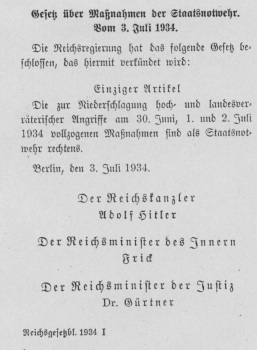
3 July 1934
Following the night of the Long Knifes, a Law Regarding Measures of State Self-Defence retroactively legalized the murders committed during the purge
Following the night of the Long Knifes, a Law Regarding Measures of State Self-Defence retroactively legalized the murders committed during the purge
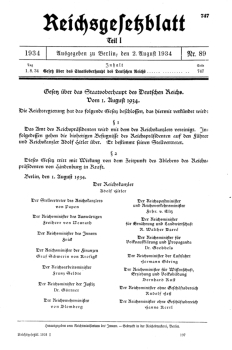
19 August 1934
Text of the plebiscite to approve the merge of the positions of chancellor and Reich president. The vote was held on 19 August, although the law was ratified on 1st August, the day before Hindenburg's death
Text of the plebiscite to approve the merge of the positions of chancellor and Reich president. The vote was held on 19 August, although the law was ratified on 1st August, the day before Hindenburg's death
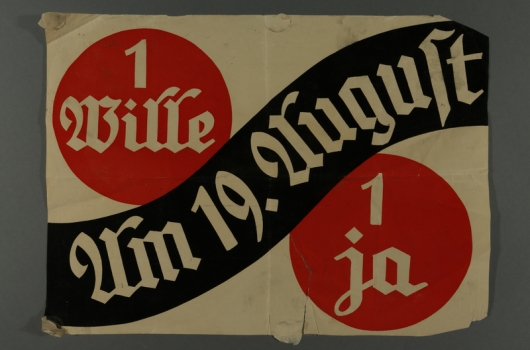
19 August 1934
After Paul von Hindenburg's death, a plebiscite was held to approve the merge of the positions of chancellor and Reich president. 89.9% of the population voted yes, giving Hitler dictatorial authority (newsprint poster acquired by an American tourist)
After Paul von Hindenburg's death, a plebiscite was held to approve the merge of the positions of chancellor and Reich president. 89.9% of the population voted yes, giving Hitler dictatorial authority (newsprint poster acquired by an American tourist)

1 November 1934
Adolf Hitler accepts to become a honorary citizen of the city of Schmiedefeld in Thuringen
Adolf Hitler accepts to become a honorary citizen of the city of Schmiedefeld in Thuringen

15 September 1935
Adolf Hitler speaks at the meeting of the Reichstag in Nuremberg during the NSDAP Rally and proclaims the Nuremberg laws (pictured is the chart for racial identification)
Adolf Hitler speaks at the meeting of the Reichstag in Nuremberg during the NSDAP Rally and proclaims the Nuremberg laws (pictured is the chart for racial identification)

15 September 1935
The 45 degree angled red, black and white swastika (hakenkreuz) flag becomes the official national flag of Germany, original sketch by Hitler
The 45 degree angled red, black and white swastika (hakenkreuz) flag becomes the official national flag of Germany, original sketch by Hitler
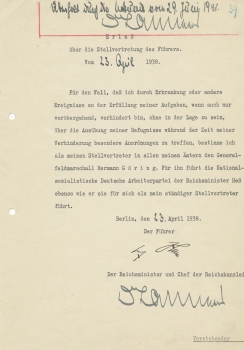
23 April 1938
Adolf Hitler names Hermann Göring as his deputy in case of illness or other incapacity
Adolf Hitler names Hermann Göring as his deputy in case of illness or other incapacity

2 May 1938
Handwritten private testament of Adolf Hitler dated 2 May 1938 (click here for the full text and translation)
Handwritten private testament of Adolf Hitler dated 2 May 1938 (click here for the full text and translation)

29 September 1938
The Munich agreement is signed by Adolf Hitler, Neville Chamberlain, Edouard Daladier and Benito Mussolini, giving Germany the right to claim the Sudetenland
The Munich agreement is signed by Adolf Hitler, Neville Chamberlain, Edouard Daladier and Benito Mussolini, giving Germany the right to claim the Sudetenland

30 September 1938
Adolf Hitler and Neville Chamberlain signed this document the day after the Munich agreement to confirm the Anglo-German Declaration of non aggression
Adolf Hitler and Neville Chamberlain signed this document the day after the Munich agreement to confirm the Anglo-German Declaration of non aggression

31 August 1939
Official order for the attack against Poland, starting World War II, which Adolf Hitler signed at 12:40 ordering the attack to begin at 4:45 the following night
Official order for the attack against Poland, starting World War II, which Adolf Hitler signed at 12:40 ordering the attack to begin at 4:45 the following night
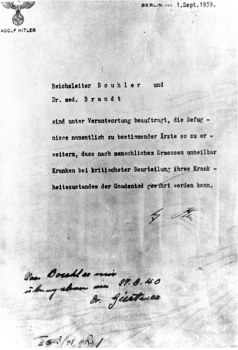
October 1939
Adolf Hitler signs the authorization for the Euthanasia Program (Operation T4) - The document was antidated to September 1, 1939 to suggest that the effort was related to wartime measures
Adolf Hitler signs the authorization for the Euthanasia Program (Operation T4) - The document was antidated to September 1, 1939 to suggest that the effort was related to wartime measures

10 June 1940
After Mussolini declared the war to France, Adolf Hitler sends a message to the Duce stating his satisfaction that both countries will fight side by side (text written by Hewel with Hitler corrections)
After Mussolini declared the war to France, Adolf Hitler sends a message to the Duce stating his satisfaction that both countries will fight side by side (text written by Hewel with Hitler corrections)

25 June 1940
Following the victory in the west, Adolf Hitler asks for the resumption of work on the new architectural layout of Berlin, Munich, Hamburg, Linz and Nuremberg
Following the victory in the west, Adolf Hitler asks for the resumption of work on the new architectural layout of Berlin, Munich, Hamburg, Linz and Nuremberg
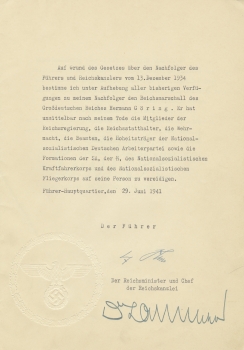
29 June 1941
Adolf Hitler names Hermann Göring as his successor in case of his death
Adolf Hitler names Hermann Göring as his successor in case of his death
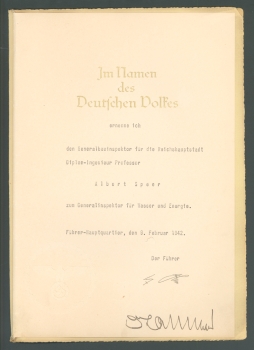
9 February 1942
Adolf Hitler appoints Albert Speer to replace Fritz Todt the day after Todt’s plane crashed, Speer would replace Todt in his 3 major positions, including Inspector General of Water and Energy, as well as head of the Organisation Todt
Adolf Hitler appoints Albert Speer to replace Fritz Todt the day after Todt’s plane crashed, Speer would replace Todt in his 3 major positions, including Inspector General of Water and Energy, as well as head of the Organisation Todt

31 December 1942
Adolf Hitler sends a condolences letter to Robert Ley after the suicide of his wife Inge
Adolf Hitler sends a condolences letter to Robert Ley after the suicide of his wife Inge
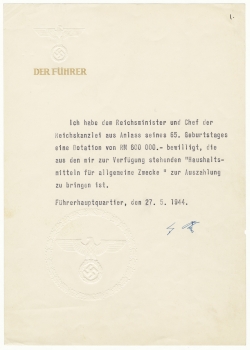
27 May 1944
Adolf Hitler gives 600.000 Reichsmarks to minister Lammers for his 65th birthday out from the budget funds available for general purposes
Adolf Hitler gives 600.000 Reichsmarks to minister Lammers for his 65th birthday out from the budget funds available for general purposes

30 March 1945
Hitler orders to the army that only the toughest resistance and fanatic determination can guarantee the success of the coming battle. The forces liberated in east and west Prussia will arrive and give orders for the final defense in Berlin.
Hitler orders to the army that only the toughest resistance and fanatic determination can guarantee the success of the coming battle. The forces liberated in east and west Prussia will arrive and give orders for the final defense in Berlin.
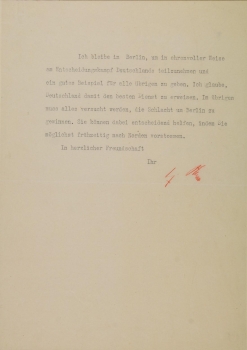
24 April 1945
Radiogram letter: I'll remain in Berlin to take part honorably in the decisive battle for Germany, and set a good example to those remaining. I believe that in this way I shall render Germany the best service. For the rest of you, every effort must be mad
Radiogram letter: I'll remain in Berlin to take part honorably in the decisive battle for Germany, and set a good example to those remaining. I believe that in this way I shall render Germany the best service. For the rest of you, every effort must be mad
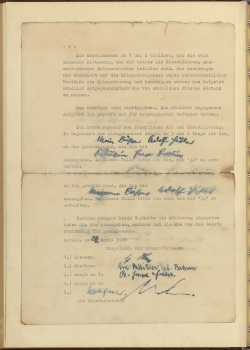
28 April 1945
Adolf Hitler marries Eva Braun in his Berlin bunker 2 days before their suicide. The wedding certificate is signed by the 2 witnesses, Joseph Goebbels and Martin Bormann, and the councillor Walter Wagner
Adolf Hitler marries Eva Braun in his Berlin bunker 2 days before their suicide. The wedding certificate is signed by the 2 witnesses, Joseph Goebbels and Martin Bormann, and the councillor Walter Wagner
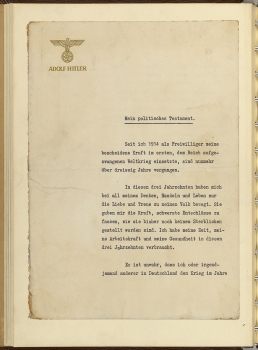
29 April 1945
Adolf Hitler dictates his political and private testaments to his secretary Traudl Junge, in his Berlin bunker, a day before his suicide
Adolf Hitler dictates his political and private testaments to his secretary Traudl Junge, in his Berlin bunker, a day before his suicide
Featured articles


